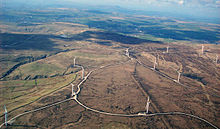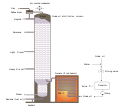Portal:Energy
| Main page | New articles & Tasks |
 The Energy Portal Welcome to Wikipedia's Energy portal, your gateway to energy. This portal is aimed at giving you access to all energy related topics in all of its forms.
|
Page contents: Selected article • Selected image • Selected biography • Did you know? • General images • Quotations • Related portals • Wikiprojects • Major topics • Categories • Help • Associated Wikimedia |
Introduction
In physics, energy (from Ancient Greek ἐνέργεια (enérgeia) 'activity') is the quantitative property that is transferred to a body or to a physical system, recognizable in the performance of work and in the form of heat and light. Energy is a conserved quantity—the law of conservation of energy states that energy can be converted in form, but not created or destroyed. The unit of measurement for energy in the International System of Units (SI) is the joule (J).
Common forms of energy include the kinetic energy of a moving object, the potential energy stored by an object (for instance due to its position in a field), the elastic energy stored in a solid object, chemical energy associated with chemical reactions, the radiant energy carried by electromagnetic radiation, and the internal energy contained within a thermodynamic system. All living organisms constantly take in and release energy.
Due to mass–energy equivalence, any object that has mass when stationary (called rest mass) also has an equivalent amount of energy whose form is called rest energy, and any additional energy (of any form) acquired by the object above that rest energy will increase the object's total mass just as it increases its total energy.
Human civilization requires energy to function, which it gets from energy resources such as fossil fuels, nuclear fuel, or renewable energy. The Earth's climate and ecosystems processes are driven by the energy the planet receives from the Sun (although a small amount is also contributed by geothermal energy). (Full article...)
Selected article
Scout Moor Wind Farm is the second largest onshore wind farm in England. The wind farm, which was built for Peel Wind Power Ltd, produces electricity from 26 Nordex N80 wind turbines. It has a total nameplate capacity of 65 MW of electricity, providing 154,000 MW·h per year; enough to serve the average needs of 40,000 homes. The site occupies 1,347 acres (545 ha) of open moorland between Edenfield, Rawtenstall and Rochdale, and is split between the Metropolitan Borough of Rochdale in northern Greater Manchester and the Borough of Rossendale in south-eastern Lancashire. The turbines are visible from as far away as south Manchester, 15–20 miles (24–32 km) away.
A protest group was formed to resist the proposed construction, and attracted support from the botanist and environmental campaigner David Bellamy. Despite the opposition, planning permission was granted in 2005 and construction began in 2007. Although work on the project was hampered by harsh weather, difficult terrain, and previous mining activity, the wind farm was officially opened on 25 September 2008 after "years of controversy", at a cost of £50 million. (Full article...)
Selected image

Photo credit: From an image by Wolfgang Beyer
Strombolian volcanic eruptions can eject incandescent cinder, lapilli and lava bombs to altitudes of tens to hundreds of meters.
Did you know?

- Buildings constructed to the German Passivhaus standard use 75% to 95% less energy for space heating and cooling than current new buildings in the United States?
- Crossing 4,000 km (2,500 miles), the Druzhba pipeline is the world's longest oil pipeline?
- Coal is ground to a powder before being burnt in fossil fuel power plants?
- Compact fluorescent lamps (pictured) use about 1/4 of the energy of normal incandescent light bulbs, and pay for themselves after about 500 hours of use?
- Nuclear power in France produces 78% of all the country's electricity - more than in any other nation?
- Positive lightning bolts are typically six to ten times more powerful than normal lightning — and aircraft are not designed to withstand them?
- Dark energy is a hypothetical form of energy which permeates all of space?
Selected biography
In 1831, Faraday began his great series of experiments in which he discovered electromagnetic induction. He established that a changing magnetic field produces an electric field, a relation mathematically modelled by Faraday's law. Faraday later used the principle to construct the electric dynamo, the ancestor of modern power generators. He went on to investigate the fundamental nature of electricity, concluding in 1839 that, contrary to opinions at the time, only a single "electricity" exists, and the changing values of quantity and intensity (voltage and charge) would produce different groups of phenomena.
Some historians refer to Faraday as the best experimentalist in the history of science. Despite this his mathematical ability did not extend so far as trigonometry or any but the simplest algebra. He nevertheless possessed the ability to present his ideas in clear and simple language. During his lifetime, Faraday rejected a knighthood and twice refused to become President of the Royal Society.
General images
Quotations
- "There are only two ways to stabilize concentration of greenhouse gases. One is to avoid emitting them in the first place; the other is to try to capture them after they're created. And there are problems with both approaches." – George W. Bush, 2001
- "The planet has a fever. If your baby has a fever you go to the doctor. If the doctor says you need to intervene here, you don't say, 'Well, I read a science fiction novel that told me it's not a problem.' If the crib's on fire, you don't speculate that the baby is flame retardant. You take action." – Al Gore, 2007
- "If the climate researchers' reports are to be believed, global warming is a huge medium and long-term threat, one which could have dramatic consequences such as refugee flows and armed conflicts." – Angela Merkel, 2007
Related portals
WikiProjects
WikiProjects connected with energy:
Other WikiProjects that may be of interest:
Major topics
Major categories
National energy supply, use & conservation
National electricity sector
Politics, economics, environment
- Climate change
- Energy conservation
- Energy economics
- Energy crises
- Energy development
- Energy policy
- Peak oil
Energy sources
- Fuels
- Biofuels
- Fossil fuels
- Fusion power
- Nuclear technology
- Renewable energy
- Energy conversion
- Electric power
- Energy storage
Energy-related design
Scientific usage
Help

Puzzled by energy?
Can't answer your question?
Don't understand the answer?
- Ask at the reference desk
- Read the Wikipedia help pages
For further ideas, to leave a comment, or to learn how you can help improve and update this portal, see the talk page.
Associated Wikimedia
The following Wikimedia Foundation sister projects provide more on this subject:
-
Commons
Free media repository -
Wikibooks
Free textbooks and manuals -
Wikidata
Free knowledge base -
Wikinews
Free-content news -
Wikiquote
Collection of quotations -
Wikisource
Free-content library -
Wikiversity
Free learning tools -
Wiktionary
Dictionary and thesaurus





























































































































































































